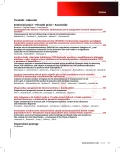Routine use of thromboelastometry (ROTEM) for coagulation evaluation (adoption of ,,new“ paradigm of coagulation evaluation) in the intensive care unit leads to a significant reduction in the administration of blood plasma
Authors:
M. Durila 1; J. Beroušek 2; T. Vymazal 1
Authors‘ workplace:
Klinika anesteziologie, resuscitace a intenzivní medicíny, 2. LF UK
FN Motol, Praha
1
Published in:
Transfuze Hematol. dnes,22, 2016, No. 3, p. 168-171.
Category:
Comprehensive Reports, Original Papers, Case Reports
Overview
Coagulopathy in patients in intensive care is very frequent, especially in terms of prolonging the activated partial thromboplastin time or prothrombin time. In actual practice, the correction of these pathological values often indicates the administration of fresh frozen plasma, especially in the perioperative period. Currently, many clinical reports proclaim that frozen plasma is often unnecessarily administered as global tests of coagulation such as tromboelastometry show that the overall coagulation is normal despite of pathological laboratory tests. In this paper we present the results of our clinic, where we show that after implementation of thromboelastometry into the daily practice and adoption of the new paradigm of cell model of haemostasis, administration of plasma was reduced by 66%. This represents a significant reduction in risk for the patient as well as the financial burden for the clinic
KEY WORDS:
thromboelastometry – ROTEM – plasma
Sources
1. Levi M, Opal SM. Coagulation abnormalities in critically ill patients. Crit Care 2006; 10(4): 222.
2. Durila M, Lukas P, Astraverkhava M, Berousek J, Zabrodsky M, Vymazal T. Tracheostomy in intensive care unit patients can be performed without bleeding complications in case of normal thromboelastometry results (EXTEM CT) despite increased PT-INR: a prospective pilot study. BMC Anesthesiol 2015; 15: 89.
3. Hoffman M, Monroe DM. A cell-based model of hemostasis. Thromb Haemost 2001; 85(6): 958–965.
4. Haas T, Spielmann N, Mauch J, et al. Comparison of thromboelastometry (ROTEM(R)) with standard plasmatic coagulation testing in paediatric surgery. Br J Anaesth 2012; 108(1): 36–41.
5. Weber CF, Gorlinger K, Meininger D, et al. Point-of-care testing: a prospective, randomized clinical trial of efficacy in coagulopathic cardiac surgery patients. Anesthesiology 2012; 117(3): 531–547.
6. Weber CF, Zacharowski K. Perioperative point of care coagulation testing. Dtsch Arztebl Int 2012; 109(20): 369–375.
7. Gorlinger K. Coagulation management during liver transplantation. Hamostaseologie 2006; 26(3 Suppl 1): S64–76.
8. Haas T, Spielmann N, Mauch J, Speer O, Schmugge M, Weiss M. Reproducibility of thrombelastometry (ROTEM(R)): point-of-care versus hospital laboratory performance. Scand J Clin Lab Invest 2012; 72(4): 313–317.
9. Blasi A, Beltran J, Pereira A, et al. An assessment of thromboelastometry to monitor blood coagulation and guide transfusion support in liver transplantation. Transfusion 2012; 52(9): 1989–1998.
10. Hayashi T, Sakurai Y, Fukuda K, et al. Correlations between global clotting function tests, duration of operation, and postoperative chest tube drainage in pediatric cardiac surgery. Paediatr Anaesth 2011; 21(8): 865–871.
11. Romlin BS, Wahlander H, Berggren H, et al. Intraoperative thromboelastometry is associated with reduced transfusion prevalence in pediatric cardiac surgery. Anesth Analg 2011; 112(1): 30–36.
12. Schochl H, Nienaber U, Hofer G, et al. Goal-directed coagulation management of major trauma patients using thromboelastometry (ROTEM)-guided administration of fibrinogen concentrate and prothrombin complex concentrate. Crit Care 2010; 14(2): R55.
13. Keene DD, Nordmann GR, Woolley T. Rotational thromboelastometry-guided trauma resuscitation. Curr Opin Crit Care 2013; 19(6): 605–612.
14. Durila M, Malosek M. Rotational thromboelastometry along with thromboelastography plays a critical role in the management of traumatic bleeding. Am J Emerg Med 2014; 32(3): 288 e281–283.
15. Patel IJ, Davidson JC, Nikolic B, et al. Consensus guidelines for periprocedural management of coagulation status and hemostasis risk in percutaneous image-guided interventions. J Vasc Interv Radiol 2012; 23(6): 727–736.
16. Liumbruno GM, Bennardello F, Lattanzio A, Piccoli P, Rossetti G. Recommendations for the transfusion management of patients in the peri-operative period. III. The post-operative period. Blood Transfus 2011; 9(3): 320–335.
17. Muller MC, Arbous MS, Spoelstra-de Man AM, et al.Transfusion of fresh-frozen plasma in critically ill patients with a coagulopathy before invasive procedures: a randomized clinical trial (CME). Transfusion 2015; 55(1): 26–35; quiz 25.
18. De Pietri L, Bianchini M, Montalti R, et al. Thrombelastography-guided blood product use before invasive procedures in cirrhosis with severe coagulopathy: A randomized, controlled trial. Hepatology 2016; 63(2): 566–573.
19. Brenner T, Schmidt K, Delang M, et al. Viscoelastic and aggregometric point-of-care testing in patients with septic shock – cross-links between inflammation and haemostasis. Acta Anaesthesiol Scand 2012; 56(10): 1277–1290.
20. Desborough MJ, Jairath V. Thrombelastography-guided blood product use before invasive procedures in cirrhosis with severe coagulopathy. Hepatology 2015.
21. Naik BI, Pajewski TN, Bogdonoff DI, et al. Rotational thromboelastometry-guided blood product management in major spine surgery. J Neurosurg Spine 2015; 23(2): 239–249.
22. Spahn DR, Bouillon B, Cerny V, et al. Management of bleeding and coagulopathy following major trauma: an updated European guideline. Crit Care 2013; 17(2): R76.
Labels
Haematology Internal medicine Clinical oncologyArticle was published in
Transfusion and Haematology Today

2016 Issue 3
Most read in this issue
- Alpha-thalassemia in 45 Czech and 37 immigrant families: review of the literature and molecular diagnosis
- Diagnosis and prognostic factors in mantle cell lymphoma
- Immunogenetic factors influencing red blood cell alloimmunization
- Correlation analysis of standard Bethesda method versus modified Nijmegen assay in detecting factor VIII inhibitors, and impact of marginal titer inhibitors on FVIII pharmacodynamics and pharmacokinetics by patients with hemophilia A
